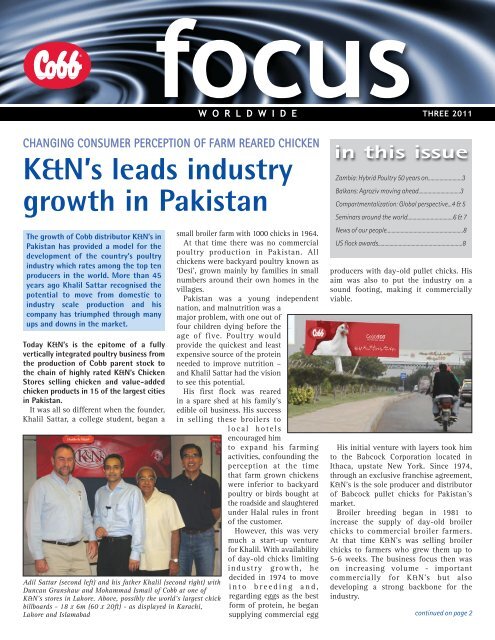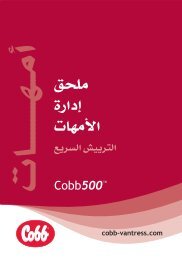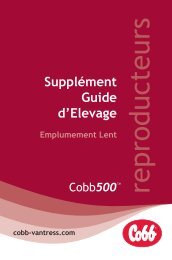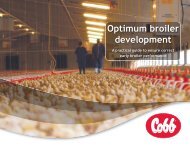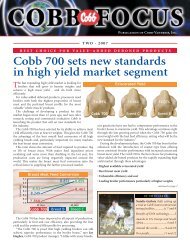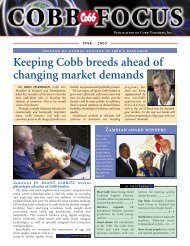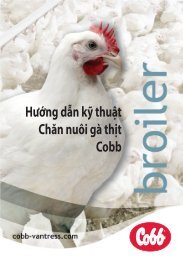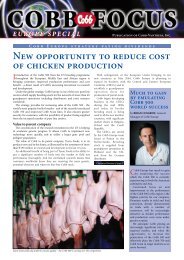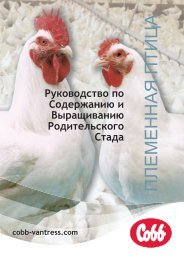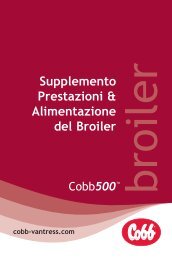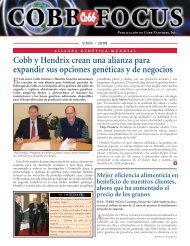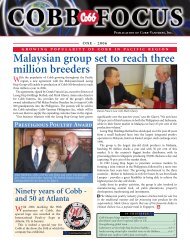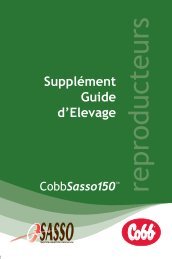Cobb Focus Three 2011 (English)
Cobb Focus Three 2011 (English)
Cobb Focus Three 2011 (English)
Create successful ePaper yourself
Turn your PDF publications into a flip-book with our unique Google optimized e-Paper software.
focusW O R L D W I D ETHREE <strong>2011</strong>CHANGING CONSUMER PERCEPTION OF FARM REARED CHICKENK&N’s leads industrygrowth in PakistanThe growth of <strong>Cobb</strong> distributor K&N’s inPakistan has provided a model for thedevelopment of the country’s poultryindustry which rates among the top tenproducers in the world. More than 45years ago Khalil Sattar recognised thepotential to move from domestic toindustry scale production and hiscompany has triumphed through manyups and downs in the market.Today K&N’s is the epitome of a fullyvertically integrated poultry business fromthe production of <strong>Cobb</strong> parent stock tothe chain of highly rated K&N’s ChickenStores selling chicken and value-addedchicken products in 15 of the largest citiesin Pakistan.It was all so different when the founder,Khalil Sattar, a college student, began aAdil Sattar (second left) and his father Khalil (second right) withDuncan Granshaw and Mohammad Ismail of <strong>Cobb</strong> at one ofK&N’s stores in Lahore. Above, possibly the world’s largest chickbillboards - 18 x 6m (60 x 20ft) - as displayed in Karachi,Lahore and Islamabadsmall broiler farm with 1000 chicks in 1964.At that time there was no commercialpoultry production in Pakistan. Allchickens were backyard poultry known as‘Desi’, grown mainly by families in smallnumbers around their own homes in thevillages.Pakistan was a young independentnation, and malnutrition was amajor problem, with one out offour children dying before theage of five. Poultry wouldprovide the quickest and leastexpensive source of the proteinneeded to improve nutrition –and Khalil Sattar had the visionto see this potential.His first flock was rearedin a spare shed at his family’sedible oil business. His successin selling these broilers tol o c a l h o t e l sencouraged himto expand his farmingactivities, confounding theperception at the timethat farm grown chickenswere inferior to backyardpoultry or birds bought atthe roadside and slaughteredunder Halal rules in frontof the customer.However, this was verymuch a start-up venturefor Khalil. With availabilityof day-old chicks limitingindustry growth, hedecided in 1974 to movei n t o b r e e d i n g a n d ,regarding eggs as the bestform of protein, he begansupplying commercial eggin this issueZambia: Hybrid Poultry 50 years on..........................3Balkans: Agroziv moving ahead................................3Compartmentalization: Global perspective...4 & 5Seminars around the world...................................6 & 7News of our people...........................................................8US flock awards.................................................................8producers with day-old pullet chicks. Hisaim was also to put the industry on asound footing, making it commerciallyviable.His initial venture with layers took himto the Babcock Corporation located inIthaca, upstate New York. Since 1974,through an exclusive franchise agreement,K&N’s is the sole producer and distributorof Babcock pullet chicks for Pakistan’smarket.Broiler breeding began in 1981 toincrease the supply of day-old broilerchicks to commercial broiler farmers.At that time K&N’s was selling broilerchicks to farmers who grew them up to5-6 weeks. The business focus then wason increasing volume - importantcommercially for K&N’s but alsodeveloping a strong backbone for theindustry.continued on page 2
D I S T R I B U T O R P R O F I L E : K & N ’ s , P A K I S T A Ncontinued from page 1In 2001 K&N’s returned to broiler growingwith larger scale, controlled-environmentfacilities, which laid the foundation forthis type of production in Pakistan.Up to then most producers had less than5,000 broilers per shed, fed them manuallyand usually housed birds in thatched roofsheds.Currently K&N’s has six broiler growingfacilities, each with capacity for 250-300,000 birds. The <strong>Cobb</strong> 500 broilers aregrown to 36 days, averaging 1.87 kg witha 1.75 to 1.85 feed conversion ratio.For all the farms and other operationsback-up generators are essential as powerbreakdowns occur regularly, can beunpredictable and last six to eight hours attimes.K&N’s s t r o n g c o m m i t m e n t t ocooperation and industry developmentencouraged new entrepreneurs, pushing updemand for day-old broiler chicks. Thislead to increased placement of parentstock, so that in 2007 Pakistan was one ofthe top ten poultry producers in the worldwith over eight million broiler parent stockproducing more than 800 million birds ayear.The expansion had also been triggeredby high prices following the drastic dropin production in 2004/05 when Pakistansuffered badly from bird flu.With over production in 2007/8 and areported bird flu case in a remote area,poultry prices crashed once again. Add tothis a 68% increase in feed cost and heavylosses were made with a 40% reduction inproduction in 2008/09.Day-old chick price at the end of 2008dropped to (Pakistani Rupees) Rs. 1-4(2008 Rs 80 = US$1) with some breedingcompanies even giving away day-oldbroiler chicks against a production cost ofover Rs 20 per chick. Consequently, almost40% of producers closed, reducing thesupply of day-old chicks and increasingtheir price. As demand recovered there wasa shortage of parent stock.This led in 2008 to K&N’s reaching anagreement to become a <strong>Cobb</strong> grandparentfranchise producing <strong>Cobb</strong> 500 parent stockfor their own breeding programme andsupplying other breeding companies tohelp rebuild the industry.“The decision was made after splithousetrials with both <strong>Cobb</strong> andcompetitor breeds, assessing parent stockperformance, broiler feed conversions andgrowth rates,” says Khalil Sattar, chairmanand chief executive of K&N’s.“We discovered the closest internationalcompetitor of <strong>Cobb</strong> required superior2Top, K&N’s processing plant; bottom, itsgrandparent farm near Abbottabadquality pellets and high density feed whichcould not be readily and extensively madeavailable in the country with the marginalnature of nutrition,” says Adil Sattar,executive director of K&N’s.“Broilers of other breeds did not competewell as we found the <strong>Cobb</strong> 500 broiler tobe the most cost effective. On the breedingside, <strong>Cobb</strong> parent stock performed as wellas any other and consequently we chose<strong>Cobb</strong>.“We feel that with <strong>Cobb</strong> 500 in Pakistanwe can contribute positively towardsenabling farmers to produce a live kg ofchicken at least cost and in the mostefficient manner.”In <strong>2011</strong>/12 K&N’s expects to produce 80million layer and broiler chicks.In the 1960’s and 1970’s, obtaining safe,reliable sources of poultry feed was aninsurmountable challenge in Pakistan. Thisled Khalil to set up his own feed mill toproduce feed for K&N’s operations atKarachi in 1971. With the growing need offeed for the integrated productionoperations in Central Punjab province andNorthern areas of the country, a feed millestablished by a multi-national companyat Lahore, was acquired by K&N’s to takeadvantage of low cost feed ingredientsavailable in the Central part of Pakistan.The growth of commercial poultryproduction through the decades changedthe mindset of consumers towards farmraised broilers and eggs, helped by lowerprices and greater availability. Today Desicontinued on page 3
When first proposed by the OIE (the worldorganisation for animal health) somesix years ago, the concept ofcompartmentalization was designed toprovide an additional level of confidenceand credential beyond geographicalborders or ‘zones’ traditionally adoptedduring a notifiable disease outbreak.With compartmentalization, industryand governments not only consider thephysical boundaries but also theepidemiological factors, includingmanagement practices and biosecurity, thathelp define an effective separation betweensubpopulations in the event of disease.The concept is aimed at helping withinternational trade and disease controlduring an active disease crisis episode inthe exporting country.For trading during a disease crisis,compartmentalization can help with themovement of commodities where ‘country’C O M P A R T M E N T A L I Z A T I O N : T H E N E X T S T E P SPreparing for the inevitable withreassurances in placeby Dr KATE BARGER, veterinary groups and quality assurancemanager/veterinarian at <strong>Cobb</strong> Europeor ‘regional’ diseasefreedom assurancescannot be authorized.Secondly, for diseasecontrol or eradicationprocedures, progressivecompartmentalizationsteps in a country mayenable a more strategicapproach for governmentrisk analysis and disease preventionmethods within a geographic area.While the purported benefits arestraightforward for exporting countries,importing countries and suppliers ofvaluable commodities, implementation hasbeen more challenging.Qualified biosecurity systemsThe OIE has clearly provided aframework for compartments, but theresponsibility lies with individual countriesfor the specific details required forinfrastructure, training ofindependent government staff toassess and approve sites, andthe notification of approvedcompartments.In various cases, implementation— Stage 2 — has been a joint effortbetween industry and government.With the elite poultry breedingindustry, exporting companieshave a clear understandingof the need to have qualifiedbiosecurity systems to help ensure thattrade disruptions are limited in the eventof a disease crisis within the country oforigin.For governments, having approvedcompartments for a defined subspeciesmay not only improve the quantity andfrequency of disease surveillance withinthe subpopulation, but should also providegreater transparency and traceability oflivestock with regards to biosecurity andepidemiological factors.Epidemiologic isolation of farms is important for disease prevention. Biosecurity measures andcompliance are, however, essential for compartment approval4Compartment expectationsTo implement compartments, countrieshave responded in different ways to set upthe procedures and assessments for theirapproved compartments.Some governments are using the OIEstandards as a basic outline forcompartmentalization. By only utilizingthe OIE standards as the primaryframework for their compartments,these governments allow companies todemonstrate the robustness of theirbiosecurity programs, epidemiologic linksand disease surveillance systems to meetthe OIE definitions for compartments.Other governments have additionallyprovided industry with stringent criteriato eliminate potential areas of selfinterpretationor leniency. These strictguidelines include clearly definedchecklists for biosecurity and managementprocedures, expectations for facilityinfrastructure, surveillance testing andbiosecurity measures that go well beyondthe basic framework of the OIE criteria.A final example of Stage 2implementation is the EU compartmentstandard that provides benchmark criteriafor EU member countries. These EU
C O M P A R T M E N T A L I Z A T I O N : T H E N E X T S T E P SStrict procedures for vehicles and personnel entry are critical to ensure epidemiologic separationStandards are more specific and provideadditional detail to basic OIE criteria.Once the national or governmentalrequirements are known, industries andindividual companies can begin toimplement Stage 2 by actively developingthe documentation and implementingbiosecurity measures to meet anyadditional compartment standardsexpected by their governments. Ascompanies complete their internal workand achieve compartment recognition bythe veterinary authority of the countrywhere their production locations aresituated, compartmentalization can thenbecome a reality.Establishing operations as compartmentselevates the company and the industry toa higher status of biosecurity and healthduring times of disease occurrence.While the process and implementation isindeed a burden and requires an incredibleamount of attention to detail, mostcompanies have found that theserequirements have improved the objectivesand assessments of their dailymanagement procedures as well astransparency of their biosecurity actions.The next step for compartmentalizationi s S t a g e 3 a n d w i l l c r i t i c a l l ydemonstrate the functionality of approvedcompartments. This phase involvesrecognition, and in some cases evaluation,of the defined compartment by theimporting country. At the recent May <strong>2011</strong>OIE meeting in Paris, a luncheon meetingwas attended by approximately 165 OIEdelegates to learn more about the UKcompartment scheme. Presentationshighlighted the UK’s collaborative effortbetween government and industry todetermine the necessary criteria forc o m p a r t m e n t s a n d t h e a c t u a limplementation and approval ofcompartments for poultry breedingcompanies located in Great Britain.‘Calm before the storm’While events like this to promote thecompartment process are vital, speakersalso stated that importing/exportinggovernmental discussions aboutcompartments must now take place5during the time of disease freedom. Thisperiod - essentially the ‘calm before thestorm’ - is vital to many exports and toproving that the compartments aresustainable.To facilitate this phase of understandingbetween governments for the purpose ofinternational trade, small changes arealready taking place. For example,updating export health certificates toinclude the text ‘compartment’ instatements related to disease freedom isjust a portion of the work that needs to becompleted.For the actual recognition and approvalof compartments to take place, theexporting government must be transparentwith the standards and assessmentsthey have provided to approve thecompartment, and also be willing toopenly share this information with theimporting government.By sharing this information in advancefor recognition of the compartment, theultimate goal will be to avoid blanketcountry-wide restrictions and lengthytrade delays during notifiable diseasesituations. This was the original goal whenthe OIE began work on compartmentsyears ago, and is still the goal for industryand governments today.In a perfect world there will be no needfor a Stage 4 — the real test of thecompartment concept during a diseasecrisis. But, as we all know, it is best to beprepared for the inevitable and to haveadditional reassurances in place longbefore they will be needed!
S E M I N A R S A R O U N D T H E W O R L DSeminars are a very useful way of updating customers with the latest technical advice, as well as enabling them to share experiencesand make new contacts. We report on the series of seminars organised by <strong>Cobb</strong> and our distributors through recent months.Out and about in FrieslandAs part of the commitment to provideworld-leading support to customers, <strong>Cobb</strong>Europe hosted their technical seminar inFriesland in northern Holland.Our customers did us proud andwe had excellent representationfrom grandparent distributorsand parent stock customers,writes Euan Meldrum, <strong>Cobb</strong>Europe marketing manager.Delegates came from all parts of theEurope – Middle East – Africa region fromIreland to Saudi Arabia and Sweden toSouth Africa. The programme was devisedfor them to learn about specific aspects ofpoultry production with practical visits andpresentations each day,The first day coveredindustry matters aroundthe world along witheconomics of poultryproduction. Days two andthree saw the delegatessplit into broiler orbreeder groups andcovering hatchery andproduction. The daysfollowing covered healthand ventilation, includinga visit to the PluimveepraktijkNoord & Oost( N o r t h a n d E a s t o fHolland Poultry Practice)for practical demonstrations.The 18 members of the <strong>Cobb</strong> ‘family’ whogave presentations during the five-dayevent were joined by twoindustry experts - Dr RonMeijerhof who spoke about theeffect on incubation on broilerperformance and Dr TonyMarangos on optimal broilernutrition for the <strong>Cobb</strong> products.Capturing the lifestyle in Friesland, thegroup learned how much the sea and canalsinfluence the day-to-day activities oflocal people and enjoyed an afternoon’scompetitive sailing, with graduation anddinner in the historic capital of the region,Leeuwarden, on the final evening.Czech group visits headquartersA visit to the <strong>Cobb</strong>-Vantress headquarters in Siloam Springs, Arkansas, USA, providedPavel Visek and Milos Zima (pictured fourth and third from right) from the Xavergengroup in the Czech Republic with an insight into how the company is expanding to meetgrowing demand for the <strong>Cobb</strong> 500.The visitors discussed with <strong>Cobb</strong>’s senior management group the changing marketsaround the world and its increasinginvestment in both research andproduction facilities, helping to securethe continuing advance in breeder andbroiler performance. They also saw USproduction facilities in Missouri.Mr Truscott commented: “I’mextremely pleased that our customer inthe Czech Republic is achieving 141chicks per breeder and sees the demandfor <strong>Cobb</strong> broilers increasing so thatmore breeders are being placed.’’6Middle East seminarfocuses on successin hot climateThe challenges of successful broilergrowing in a hot climate was the theme ofa <strong>Cobb</strong> Europe seminar for 40 Middle Eastcustomers in the Mzaar mountain resort inLebanon.<strong>Cobb</strong> Europe sales and technical directorPelayo Casanovas, the first of eightspeakers, spoke about how <strong>Cobb</strong> serves theglobal market and how its products aregaining share in the European, Middle Eastand African region.Regional sales manager MohammedChail gave an update on the markets withinthe Middle East, then <strong>Cobb</strong> geneticist GosseVeninga looked into what to expect from<strong>Cobb</strong> products in the future.Technical topics from the <strong>Cobb</strong> Europeteam made up the majority of thepresentations with Mark Foote from the UKdiscussing incubation principles andfactors influencing broiler performance.Broiler nutrition was covered by consultantDr Tony Marangos, while <strong>Cobb</strong> Europetechnical manager Matthew Wilson sharedglobal experiences on growing broilers in afeed efficient and successful way.<strong>Cobb</strong> Europe veterinarian Dr AndreDerkx talked about disease preventionmeasures and how to ‘read the signs’ ofinfectious viral diseases and vaccinationprograms, getting the right one for eachcircumstance.<strong>Cobb</strong> regional technical managerMohamad Kallas commented: “I amdelighted to have so many of ourcustomers with us in Lebanon. The groupgained knowledge not only from mycolleagues but also from each other, facingsimilar conditions and challenges in theirown markets.”
S E M I N A R S A R O U N D T H E W O R L DGreat future forecast for Ukrainian chicken industryThe growing importance of Ukraine as a chicken-producing country wasreflected in support for the <strong>Cobb</strong> Germany two-day seminar in Cherkasyon the banks of the River Dniper.Cherkasy was chosen because the region is the leading producer ofbroiler meat in Ukraine, and provides the location for one of Europe’slargest broiler complexes - Myronivski belonging to MironivskijHleboprodukt.Opening the event James Truscott, <strong>Cobb</strong> Germany director, said that in10 years the <strong>Cobb</strong> 500 had become the market leader in Ukraine.“We are grateful to <strong>Cobb</strong> Germany – it not only supplies excellentservice but the product we need, the <strong>Cobb</strong> 500,” commented MaximPisarev, Mironivskij Hleboprodukt director of production.Many young people were among the delegates. “Their keen interestshows why Ukraine is becoming a leader in supplying quality chickenmeat,” added Mr Truscott. “The country has a great future ahead of it withskilled specialists running the large production facilities.”World technicalschool proves itsvalueForty four participants from 25 countries(pictured below) took part in the 12thworld technical school organized by<strong>Cobb</strong>-Vantress at Siloam Springs,Arkansas, USA.This year for the first time othercustomers were able to share in some ofthe live presentations through a webcastwhich can still be accessed through thecompany’s website.A feature of the 12-day program is thenumber of case studies presented to theschool. “We introduced case studiesseveral years ago and they now play acentral role in giving the participants reallife experience of specific issues on thefarm and at the hatchery,” said GailThorp, <strong>Cobb</strong> production administratorwho organized the event.“We’ve more than doubled the size ofthe school since they began and weRenowned specialists for <strong>Cobb</strong>Hungarian seminarMore than 80 <strong>Cobb</strong> customers and otherkey players from the Hungarian chickenmeat industry came together for thetwo-day seminar near Inárcs, nearBudapest, to hear presentations fromthe world renowned specialists.The event, organised by <strong>Cobb</strong>Germany at the Bodrogi Kúria Hotel, wasintroduced by director James Truscottand László Kőrösi, sales manager forHungary, who said the aim was to helpcustomers take full advantage of the<strong>Cobb</strong> 500 genetic potential.Technical presentations covered theimportance of accurate incubation inalways receive very positive feedbackabout their value in terms of sharingcontacts between customers in differentcountries as well as learning and updatingtechnical knowledge.”The program included visits to theproviding for the chick’s temperatureneeds (consultant Dr Ron Meijerhof),heat stress related to different climaticconditions (Dr Andrea Molnár) and theimportance of ventilation in achievinggood environmental conditions(Matthew Wilson, <strong>Cobb</strong> Europe technicalmanager).Winfridus Bakker, parent stockspecialist in the team, explained how toachieve top results during the peakproduction of a <strong>Cobb</strong> 500 parent flock,while nutritionist Tony Marangosdiscussed nutritional strategies for theseflocks.University of Arkansas, breeder andbroiler farms, a hatchery, processing plantand the Tyson Foods Discovery Center aswell as presentations by members of the<strong>Cobb</strong> World Technical Support Team andinvited specialists.7
Poultry Federationhonor for Jerry MoyeJerry Moye, presidentof <strong>Cobb</strong>-Vantress, wasn a m e d t h e ‘ 2 011Industry Leader of theYear’ by the PoultryFederation during the52nd Annual PoultryFestival in Rogers,Arkansas, USA.The award formerlytitled ‘Man of the Year’has been awarded since 1955 and recognizesthe outstanding achievements of poultry andegg executives and their contribution to theindustry.Jerry completed in 2010 a three-year term onthe Poultry Federation’s board of directors andis currently serving another term - he is one ofthe very few directors to serve two consecutiveterms as chairman.“During his tenure, there was never a job toosmall or too large for him to tackle and hisleadership as chairman is well recognized,”says the Federation.N E W S O F O U R P E O P L EFlock survey award for George’sGeorge’s Inc, located in Springdale, Arkansas, was the recipient of the US<strong>Cobb</strong> 500 Sold Flock Survey Award.The award is given to the top producing complex with the highest average totaleggs per hen housed. Chance Bryant and Bob Ickes from <strong>Cobb</strong> presented the awardto Ricky Pinkerton, George’s breeder manager.Chance Bryant comments: “George's breeder personnel have worked veryhard, remained focused on the basics and functioned as a team, makingtremendous improvements over the last few years to achieve this performance.We congratulate them on earning this well deserved award."Joining the teamRoger Vessell, who hasbeen appointed directorof world marketing for<strong>Cobb</strong>-Vantress, bringsover 26 years of sales andmarketing experience.He has been seniormarketing manager forthe past five years withHolt Caterpillar at SanAntonio, Texas.Previously he was vice president -sales and marketing with Columbia300 in San Antonio and held brandmanagement positions with RawlingsSporting Goods.He obtained his BSc in socialsciences from the University ofMissouri Rolla, and is currentlycompleting his MBA from MissouriState University.Roger and his wife Joan, who have twosons and a daughter, will be relocatingto Northwest Arkansas.Dr Annsofie Wahlström hasbeen appointed as nutritionistfor <strong>Cobb</strong> Europe to servecustomers in Europe, the MiddleEast and Africa and also beinvolved in nutritional aspectsof research.For the past seven years shehas been working with Sweden’slargest feed company, LantmannenLantbruk, where she waspoultry feed nutritionistand product manager forbroiler, turkey and breederdiets.She gained a mastersdegree in animal sciencefrom SLU, the SwedishUniversity of Agriculture,and then a PhD In 1999studying diet and hybrid interactions inlaying hens.Cesar Coto has joined the<strong>Cobb</strong> North America TechnicalService Team, responsible forproviding technical advice tocustomers throughout CentralAmerica and the Caribbean.Cesar, who has been atechnical manager for DSMNutritional Products in thissame region, is a graduate of the Universityof Arkansas where he completed a PhD inpoultry science in 2010 as programassociate in the laboratory of Dr ParkWaldroup.He began his studies with a five-yearprogram in animal science in his nativeCosta Rica and after an initial two-yearperiod with DSM resumed his studies atthe University of Arkansas, gaining anMS in poultry science and then inagribusiness.<strong>Cobb</strong>-Vantress, Inc Tel: +1 479 524 3166 Email: info@cobb-vantress.com<strong>Cobb</strong> Europe Ltd Tel: +44 1206 835835 Email: info@cobb-europe.com<strong>Cobb</strong>-Vantress Brasil, Ltda Tel: +55 (17)3267 9999 Email: cobb.info@cobb-vantress.com<strong>Cobb</strong>-Vantress Philippines Inc Tel: +63 2 634 35908cobb-vantress.com


